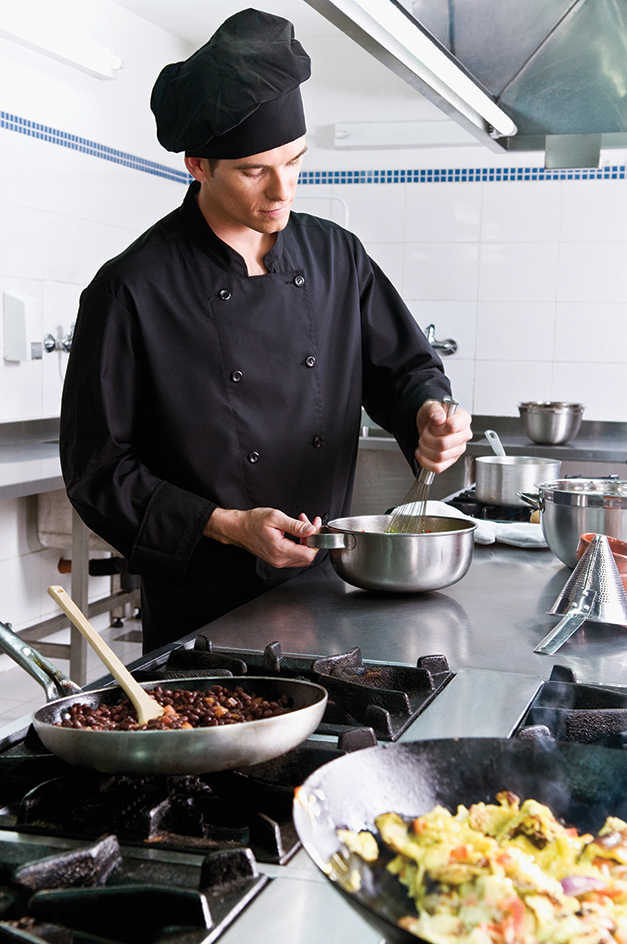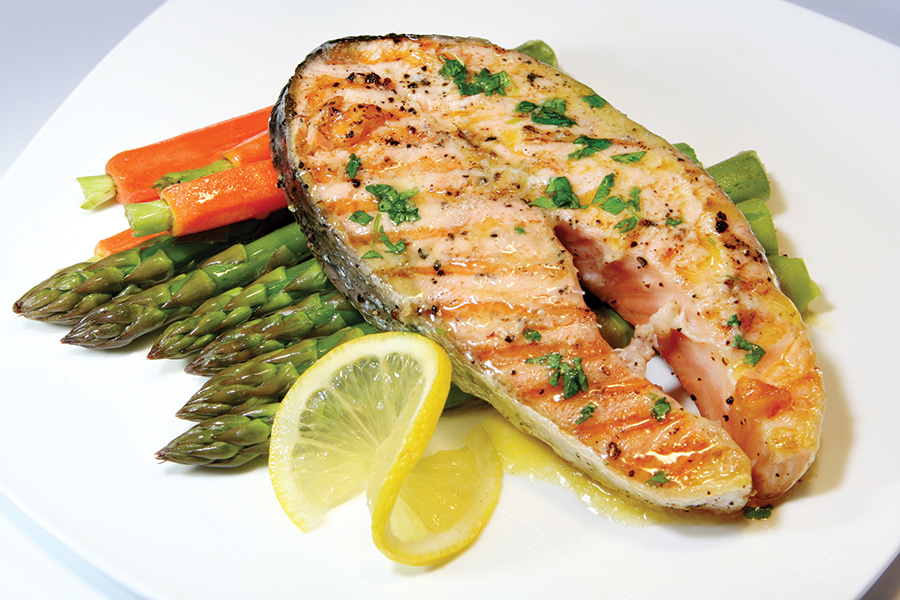Cooking includes a variety of techniques for preparing food, usually by applying heat. People cook foods for many reasons. Cooking can kill bacteria and other harmful organisms. It can make ingredients easier to digest. Cooking can also bring out the flavors in foods and create new ones.

People cook to provide meals or snacks for themselves and their family and friends. For many people, cooking is also a hobby. For some people, cooking is a profession.
Some dishes are easy to cook. They require little skill and only a few ingredients. Other dishes are so complex and carefully prepared that they resemble works of art. Recipes offer instructions for cooking a huge variety of dishes.
The ingredients used in cooking help determine food’s flavor, texture, and nutrition content. Almost any edible part of plants, animals, or fungi can be used as an ingredient. The flavors, textures, and smells of ingredients—as well as their colors and shapes—create unique eating experiences.
The cuisines (cooking styles) of many cultures begin with ingredients traditionally available in a particular region. But today, many ingredients—such as garlic, onions, and tomatoes—are used all over the world.
Cuisines
Often, a certain combination of ingredients forms the foundation of a particular cuisine. For example, Cantonese cuisine, based in southern China, makes much use of scallions, garlic, and ginger. Greek dishes often include garlic, olive oil, and oregano.
Cuisines are often based on locally available ingredients. In the coastal city of Boston, for example, traditional favorites include such seafood dishes as clam chowder and lobster. Many cuisines reflect the variety of cultures in an area. In Louisiana, for example, such dishes as gumbo (a spicy stew) combine African American, Native American, and French cooking traditions.
Preparation of ingredients
Many ingredients must be prepared before cooking. Some fruits and vegetables must be peeled. Cooks may remove the skin, bones, and fat from meat or the shells from seafood. Cooks may also cut ingredients in a variety of ways, including dicing (cutting into small cubes) and mincing (chopping extremely fine). The size of the pieces helps determine how fast they cook, as well as the texture of the finished dish. Many cooks season food with salt, spices, and herbs before cooking.

Ingredients must be prepared with safety in mind. Fruits and vegetables should generally be rinsed to remove any residues from agricultural chemicals. In addition, raw meats may contain disease-causing organisms. Proper cooking usually kills such organisms. But anything the meat touches can also become contaminated. Cooks must thus be careful when handling raw meat. They can help prevent food-borne illness by using soap and hot water to wash their hands, along with any surface that has touched raw meat.
Methods
Heat can transform the flavor and texture of ingredients. Browning meat and other ingredients, for example, involves complex chemical reactions. Fruits and vegetables contain sugars that caramelize when browned. The reaction in browning proteins, such as those in meat and poultry, is called the Maillard reaction after Louis Camille Maillard, the French chemist who discovered it. The Maillard reaction produces many new chemical compounds. These compounds give the food new flavors and aromas.
The browned bits of food that stick to a pan are called fond, a French word meaning bottom. Many sauces make use of the rich, complex flavors of fond.
Browning can only occur at temperatures above the boiling point of water, which is 212 °F (100 °C) at sea level. For this reason, moisture around the exterior of food must evaporate before the food can brown. Air and fat, as well as the metal surfaces of pans, can reach extremely high temperatures in browning. But cooking ingredients at high temperature for too long removes moisture, turning food dry and chewy. Skilled cooks will therefore carefully control both heat and moisture when cooking.
Cooking with dry heat
involves exposing food to hot air. As the air moves around the food’s surface, its heat is transferred to the cooler food.
Roasting
traditionally involved cooking large pieces of meat—or even a whole animal, such as a pig or a lamb—over an open fire. But today, roasting generally refers to cooking food in a hot oven.
Roasting meat or vegetables in a high temperature oven—above 400 °F (205 °C)—causes the food to brown quickly. But high temperatures can also dry out food. Cooks thus sometimes brown meat and then finish it in a lower temperature oven to keep it moist inside. Cooks often roast ingredients on a rack above a roasting pan, enabling hot air to reach all sides of the food.
Baking
is similar to roasting but mostly refers to making bread and such desserts as cakes, cookies, and pastries. Some other dishes are said to be baked when cooked in a hot oven. Such dishes include lasagna, whole potatoes, and whole squash.
Grilling and broiling
expose food to intense, direct heat from an open flame, quickly browning and cooking it. Grilling generally involves an outdoor gas or charcoal grill, with a flame below the food. Broiling, on the other hand, uses a heat source above the food. Grilling and broiling are often used for tender, relatively small cuts of meat, such as steaks and pieces of chicken. Such vegetables as eggplant and zucchini are also popular for grilling and broiling.
Cooking with fat
uses oil, butter, or other fatty substances at high temperatures. The hot fat transmits heat to the food more efficiently than hot air does. The fat remains liquid during cooking. Cooks use oils more often than butter for this method, because butter starts to burn at a relatively low temperature.
Sautéing
is cooking food in a shallow pan—such as a skillet—coated with a small amount of fat. Moisture on and around the food quickly evaporates in sautéing, because of the high heat and the open pan. Shed of its outer moisture, the food can then brown. Crowding a skillet with too much food prevents browning, because not enough moisture can evaporate.
Only small cuts of ingredients can be effectively cooked through sautéing. Cooks often sauté larger cuts of meat first to develop browning. They then finish cooking them in the oven. Some cooks coat foods in flour or bread crumbs before sautéing, adding texture. After sautéing, a cook can add a small amount of liquid to the hot pan and scrape up the fond. This process, called deglazing, is used to create flavorful sauces.
Sautéing is similar to stir-frying. In both methods, small cuts of food cook quickly in a small amount of fat. But cooks typically stir-fry in a high-sided pan called a wok, which may have a round bottom. The cook constantly moves the ingredients around. The wok’s sides are cooler than the bottom, varying the temperature at which the food is cooked.
Frying
involves cooking food in a larger amount of fat than does sautéing. The fat must be about 350 °F (175 °C) or slightly hotter. If the fat is not hot enough, the food may absorb too much of it, becoming greasy.
In pan-frying, the cook fills a shallow pan with fat to about halfway up the sides of the ingredients. The ingredients are cooked on one side, and then usually flipped to cook the other.
In deep-frying, the cook submerges the entire ingredient in a deep pan filled with fat. Some deep-fried foods—such as fried chicken, onion rings, and Japanese tempura—are coated in a batter before frying. The batter becomes crisp in the hot fat. Other foods, such as French fries, may be fried without any coating.
Cooking with moist heat
makes use of hot water or such water-based liquids as broth or wine to heat foods. Unlike fats, water can only get as hot as around 212 °F (100 °C). This temperature is too low for browning food. But moist-heat methods can heat food more gently and for longer periods.
Boiling
is cooking food in rapidly bubbling water that is as hot as possible. Cooks commonly boil pasta and such vegetables as broccoli and peas. They often add salt to boiling water. The food absorbs the salt for added flavor. Salty water also has a slightly higher boiling point than regular water, so the food cooks at a slightly higher temperature. Meat is generally not boiled because it can become tough and chewy.
Simmering
is cooking in liquid that has reached the boiling point of water but is not bubbling vigorously. In simmering, only a few bubbles break the surface every few seconds. Simmering cooks food more gently than boiling does. Rice is typically simmered, and potatoes are often simmered. Meat and vegetables can be simmered in water to create broths for soups. Poaching is a form of simmering. It traditionally involves the use of a slightly acidic liquid for cooking eggs and chicken. The acid helps the ingredients hold their shape.
In stews, meats and vegetables cook in a flavorful simmering liquid. The ingredients take on the flavor of the liquid and contribute their own flavor to it. A long simmering time—such as two to four hours—can transform the texture of ingredients. For example, some cuts of meat are not suitable for dry heat cooking, because they become too tough and chewy. But simmering gradually breaks down the stringy connective tissues in such meats, making them tender.
In some stews, meats are first sautéed to develop flavors from browning. A fricassee is a light-colored stew often made from veal or chicken, typically without browning the meat. In a south Asian dish called curry, fragrant spices—often cooked in oil or another fat—give strong flavors to the simmering liquid. Braising is similar to stewing, but the ingredients are only partially covered with the simmering liquid.
Steaming
means cooking food in water vapor. Water vapor is the gas that water turns into when it boils. The steam is usually the same temperature as boiling water, so it does not brown food. To steam food, cooks typically place it on a rack or a pan with holes. The rack or pan is set above boiling water so that only steam touches the food. Steaming can preserve nutrients (nourishing substances) that would leach (leak) out in simmering or boiling. In the United States and Europe, cooks mainly use steaming for vegetables. But Asian cooks steam a wide variety of foods, including dumplings and pork ribs.
Other cooking methods.
Some cooking methods do not even use heat. For example, a Latin American dish called ceviche uses acid from lemons, limes, and other citrus fruits to “cook” seafood. The acid reacts with the fish, giving it a firm texture similar to that of cooked fish. Other methods use new technologies to heat foods.
Microwave cooking
relies on the physical properties of microwaves to cook food. Microwaves are a kind of electromagnetic radiation, like radio waves and visible light. But microwaves have higher energy than these other two types. Inside a microwave oven, food is bombarded with microwaves. Moisture inside food absorbs the energy from microwaves, turning to steam. This transformation cooks the food relatively quickly, without browning. People often use microwaves to heat beverages, leftovers, and frozen food.
Vacuum cooking,
also called sous-vide, is the cooking of food in sealed plastic pouches. The pouches have all the air sucked out, creating a vacuum. They are submerged in warm water, cooking the food slowly. The long, gentle cooking, along with the vacuum, preserve the food’s flavor and moisture. Such cooking prevents flavorful juices from leaking out or evaporating. In addition, the vacuum protects food from many harmful microorganisms. But some microorganisms, such as the bacteria that causes the food poisoning botulism, can survive in a vacuum.
Molecular gastronomy,
also called experimental cuisine, uses industrial products and techniques to create food with unusual properties. For example, cooks can use the extreme cold of liquid nitrogen to quickly freeze soft or liquid ingredients into spheres or other shapes. Such techniques often depart from traditional ideas of how foods look, feel, and taste.
